Christoph "Haley" Ries Solar Eclipse page
Clicking into the small diagram shows you the development of a Solar
Eclipse.



Here you can participate the magic of natures spectacle of a Solar
Eclipse.
New images can be viewed here.
The whole gallery can also be watched
at this way .
How many time did we spent in the Moon's umbra so far?
Here the answer: Gabi: 9 minutes 37 seconds, Haley: 18 minutes 55 seconds.
This gallery is arranged this way: The last Eclipse you'll find on
top, then all other Eclipses, starting with the oldest one, are following
in chronological order. Beside every eclipseplace you'll find the Saros
number and the length of every Eclipse at each observation place. So that
no one has to scroll through the whole page here are all links to the
individual Eclipse impressions:
Egypt 2006, Mexico 1991 ,
Chile 1994, Curacao 1998,
Bismarck Observatory 1999,
Australia 2002 and finally Mt. Wendelstein 2003
.
This gallery is off course always under construction.


Total Solar Eclipse at 29th March 2006 - El
Salloum Egypt (Saros 139, 3'55"):
During evening of March 28th 2006 coming from Alexandria our group,
Gabi, Franz, Uli, Bernd and myself, as well as Tarek our guide and Mahmud
our smart driver, reached the official Eclipsecamp of El Salloum, situated
in the military restricted area directly towards the egyptian-libyan
border. A mood like on a fairground collected us but we had to reservate
our sleeping places inside the large tent of our organisation, then
setup a few telescopes, take a small diner and drink a Stella against the
little shock. Then with fresh picked up courage we managed the job to get
a good spechtling place. Happily a great open space was beside our tent,
lots of cars and buses stood in front of it, the space stretched from west
to east along the perimeter fence. I picked up the Schdoffal mount and
placed it far enough from light and rumour into the wet sand. Then our
other scopes were placed beside it and our four-by-four was parked in
front of this site. So the equipment could be setted up until the eclipse.
The immense humidity blurred the spechtling mood, there was also brightened
sky less from our camp but mostly of the bright lights of the border
facilities. At the morning of the Eclipse it was really foggy but the
rising Sun heated the mist away. During the course of the Eclipse Sun and
Moon had a date together and showed us an impressive spectacle of nature.
Due to excellent seeing the granulation of the Sun's disk was even in the
dimmed Schdoffal spectacular, as well as the sharp contour of the Moon's
edge. During this Eclipse the Flying Shadows were also good visible, Bernd
has placed a white foil on the floor. Most impressive was the view of
Totality though the ten inch Schdoffal with the 20mm Nagler. This was
the hauling worth while! This promeniences, this fine strucutures in the
corona, wonderful! Like always the Eclipse was too fast over and the pale
light was replaced by glistening brightness. We stood on the site until
the end then we backed off from the scenery and Tarek and Mahmud brought us
to Siwa.

In the occasion of these event I designed a t-shirt for our group.
For this purpose a t-shirtshop has been konfigured, not only suitable for
our intern use, everybode can order a shirt from this source. Beside this
there are also products related to the theme "Bismarck Observatory". If you
are interested you can watch the new motives under
this link.
The above image and the link behind it (filesize 740 KB) should serve
as a little teaser. (Professionals may state that the animation is not
really correct. It shows quasi a mirrored image of the real situation. But
there was anyway no Total Eclipse over the Pyramids. *g*). The poster
of the Eclipse is the official poster of the egyptian tourism authority.
A few of the following images derive by courtesy of Franz, thank you for
this:
Wet morning mood
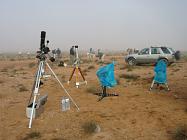
|
The official poster
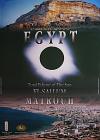 |
Equipment setup
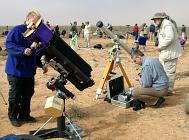
|
| At the morning of March 29th the wet fog is still ruling but we are
optimistic. |
The official Eclipsemotiv, seen in Alexandria. I liked it much. |
Schdoffal and Uli's machinery are ready to rumble, yet the Sun is
showing itself. |

Here you'll find a
500 Kb sized Jpeg version of this 360 degree panoramic view, taken short
before beginning of the partial phase.
It has begun
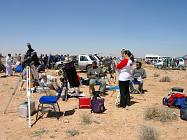
|
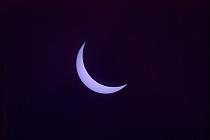 |
| The first images are already done. |
Partial phase with sunspots about 20 minutes before 2nd contact.
|
Diamond ring - 2nd contact
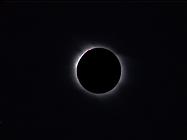 |
Totality
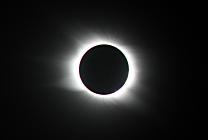
|
| Diamond ring, stacked image of the D8 camcorder video. |
Totality, taken with the Canon Ixus 430 at the 400 telelens with
eyepiece projection. |
Corona fullsize
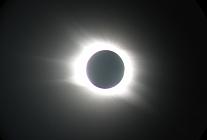
|
Short before finish
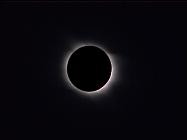 |
Diamond ring - 3rd contact
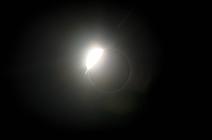
|
| Here the corona, a little longer exposured. |
Again a stacked video image, short before finish. |
The diamond ring, just about captured with the Ixus. |
Corona terrific!
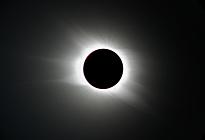
|
Promeniences
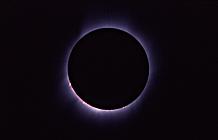
|
Corona composit
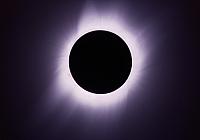
|
| This composit of 5 Ixus images shows the full splendor of the Suns
Corona. The composit is done with Gimp. |
Promeniences are appearing in the 10" Schdoffal. |
Composit from four Fuji Senisa 200 images, composed with Gimp.
|
The image row above is now showing images with 1.1m focal length,
taken with the Fuji Senia 200 through the Schdoffal telescope.
Furthermore this gallery could be extended if there will be time for
further processing of the material. Here two spectacular animations hidden
behind the following images: Regard: both animations have a size of more
than 2 Mb's! Source and Copyright of the satellite animation: Eumetsat.
Eclipse movie
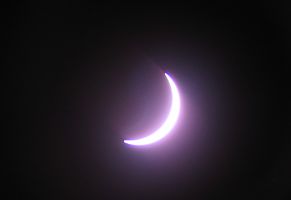
|
Satellite movie
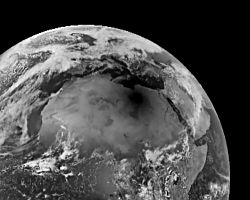 |
| Komplete Eclipse, made from all Ixus images. |
So did Meteosat saw the Eclipse. |
Thumb probe
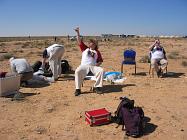
|
King of the desert
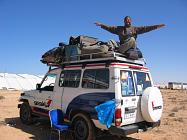
|
| The work is done, the Eclipse is over. |
The equipment is stored, Mahmud is ready for driving. |

Total Solar Eclipse at July 11th 1991 in Baja
California Sur (Saros 136, 6'51"):
This was Bismarcks greatest moment. The 500 pound scope spent it's
first session inside the moon's shadow:
Acampamiento Scientifico
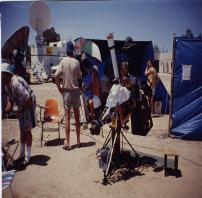 |
During totality
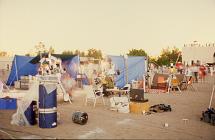 |
| Bismarck at July 11th 1991 short before the eclipse. Equipped with
large field camera and guiding scope. |
The area of the University of La Paz with amazed people inside the
lunar shadow light. |
More than six minutes...
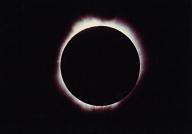 |
...totality!
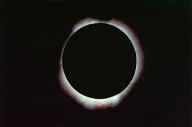 |
| Exposure of the Total Solar Eclipse from July 11th 1991 through
Bismarck's 3 1/2 inch guiding scope. |
After about six minutes the Moon moved obviously but totality is
still not over! |
This Total Exlipse was one of the highlights of my astronomic life. Not
only because it was my first totality, but also because it lasts about six
and a half minutes. An almost plentiful timespan, instead it's rapid
passing by, like always at such opportunities.

Total Solar Eclipse at November 3rd 1994 at
Parque Nacional Lauca in Chile (Saros 133, 2'55"):
Diamond ring at beginning of totality
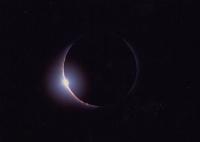 |
Corona at mid totality
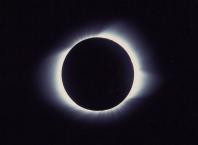 |
Christina in the mornings before Eclipse
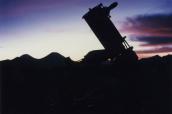 |
This Eclipse lasted a little less than three minutes. A few were worried
about the rain showers in the night before Eclipse, but our team was able
to spechtle in the hours before dawn.

Total Solar Eclipse at February 26th 1998 in
Curacao (Saros 130, 3'28"):
Observation instrument was there the 4 1/2 inch Samti:
Samti, Maksutov
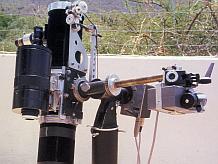 |
During totality
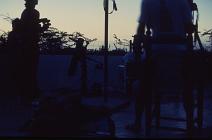 |
The so called "M1 Mount" was equipped during this expedition with the
Samti, a Newton exclusively used for spechtling, and a 1000 mm Maksutov.
The exposures in the row below were made with this scope. Samti came
also at the Eclipse 1999 to use. The Eclipse images from
Australia .are showing the metamorphosis
of this instrument in fall 2002.
The row of images is showing from left to right the diamond ring at
beginning of totality, a 1 second shot of totality, a short exposed picture
of the same situation as well as again the diamond ring effect at the end
of totality. This eclipse lasted about four minutes.

Total Solar Eclipse at August 11th 1999 at
the Bismarck Observatory (Saros 145, 1'44"):
The instrument assembly at the Observatory:
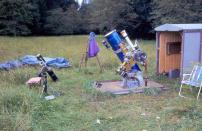
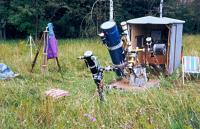
The instrument array is stretching from Bismarck which was used only
visual to the 3 1/2" guiding scope used for photography towards the
4 1/2". This array braved the elements. Because of the thick clouds and
sporadic rain showers at the site it was not possible to get images from
the two minutes lasting totality. The images of the partial phases are as
well pretty cute:
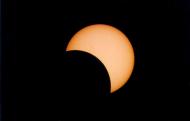
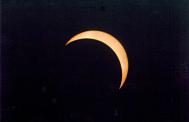
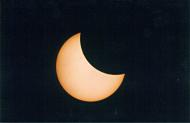
For user with fast connection the clicking into the satellite image
or here is worthwile.
Attention: Filesize is 3.3 Mb!
Speeding of the Moon's shadow above Europe. Check the massive clouds!
Remark to this animation: Source and copyright are no longer known to me.
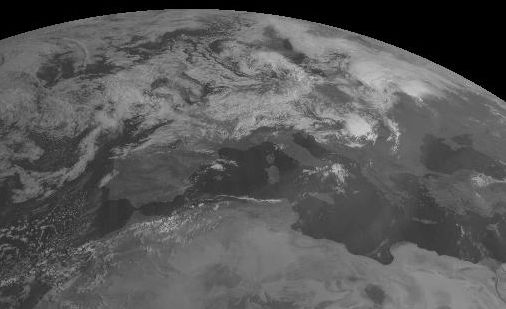
Course of the Solar Eclipse above Bavaria. The place of the TBO is
marked:


Schdoffal, Gabi and Schachdaldeifi-Samti are waiting for the
Eclipse
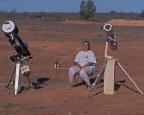 |
The eclipsed Sun is standing only a few degrees above horizon.
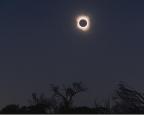 |
ULT Schdoffal short after beginning of the Eclipse
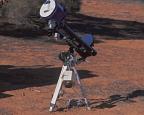 |
More images from Australia and a small report
about this 30 second Solar Eclipse spechtled from us at the
Lake Everard you'll find
here.

Partial Solar Eclipse at May 31st 2003 - seen
from Mt. Wendelstein summit (Saros147):
Although this Eclipse was only partial it's worth wile presented here!
Such a spectacular sunrise is rare observable. It outclassed in it's beauty
even the sunset of the also partial eclipsed sun 6 month ago in
Australia..
The most impressive...
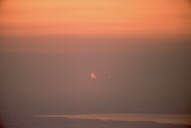 |
...sunrise since...
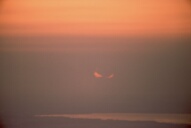 |
...many years!
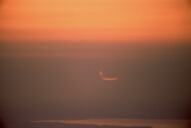 |
The upper image row and the first image of the next row are done with
a traditional SLR Camera through the 400 mm telelens.
Solar croissant above Lake Chiemsee
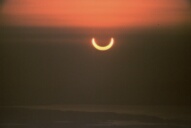 |
The Sun gaines brightness
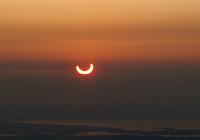
|
The Moon is backing out.
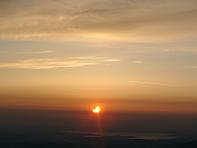
|
| The partial eclipsed Sun raises majestically above Lake Chiemsee.
|
This and the next image are taken with the Casio digicam. |
With increasing height the Sun gaines brightness, a protective solar
filter is now necessary. |



 Here you can watch
the story of our complete egyptian travel with lot's of images (at this
time only in german)
Here you can watch
the story of our complete egyptian travel with lot's of images (at this
time only in german)
 More landscape imaging from the egyptian desert at the nature page. (also
in german).
More landscape imaging from the egyptian desert at the nature page. (also
in german).









 To the Bismarck gallery with travel images
To the Bismarck gallery with travel images To the Bismarck start page.
To the Bismarck start page. More landscape images from our US travels at the nature page.
More landscape images from our US travels at the nature page.



 Here you can find more images from Christina and the ULT
Here you can find more images from Christina and the ULT At the nature page more impressions from this voyage.
At the nature page more impressions from this voyage.


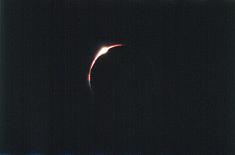
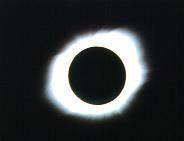
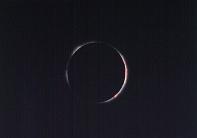
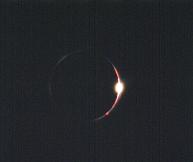










 To the Astrophoto gallery
To the Astrophoto gallery To the Bismarck gallery.
To the Bismarck gallery. To the planet page
To the planet page  Back to
start page
Back to
start page


























